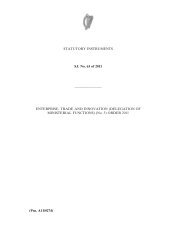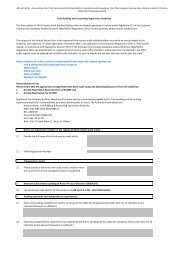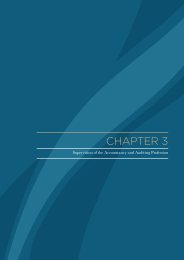View - Esma
View - Esma
View - Esma
You also want an ePaper? Increase the reach of your titles
YUMPU automatically turns print PDFs into web optimized ePapers that Google loves.
The enforcement decisionThe enforcer was of the view that the arguments supporting A or B as the acquirer were finely balanced andtherefore it was difficult to identify an acquirer in the case. In accepting the issuer’s proposal that A beidentified as the acquirer, the enforcer was influenced by the facts that:- A issued the equity interest (IFRS 3, paragraph 21);- A was the entity giving up the cash or other assets (IFRS 3, paragraph 20b); and- A had the marginal controlling interest (50.2%)Rationale for the enforcement decisionIFRS 3 requires an acquirer to be identified in all business combinations, the acquirer being the combiningentity that obtains control of the other combined entity. Guidance to be applied in determining the acquirer isprovided in paragraphs 19 to 21 of the standard.Control is defined as the power to govern the operating and financial policies of an entity or business so as toobtain benefits from its activities. There is a presumption that an entity achieves control over another entity byacquiring more than one half of the voting rights, unless it can be demonstrated that such ownership does notconstitute control.When there is an exchange of equity interests in a business combination, the entity that issues the equityinterests is normally the acquirer (paragraph 21). In this case, as the majority of the purchase consideration issettled in equity instruments, entity A would appear to be the acquirer. Yet, as the paragraph states, allpertinent facts and circumstances should be considered to determine which of the combining entities has thepower to govern the financial and operating policies of the other entity.The shareholders of entity A, the smaller of the two combining entities, appear to have obtained control since,in terms of voting rights, their share amounts to 50.2% after the transaction. A controlling ownership howeverdoes not necessarily mean that the entity has the power to govern the combined entity’s financial andoperating policies so as to obtain benefits from its activities as is explained in IFRS 3 paragraphs BC 57 - 58.Given the finely balanced distribution of the voting rights – 50.2% and 49.8% - and the existence of asignificant individual shareholder, the enforcer was of the view that the identification of the acquirer shouldtake account of the criteria set out in paragraphs 19 to 21 of the standard.IFRS 3, subparagraphs a to d of paragraph 19 consider circumstances where a combining entity might obtaincontrol over another even if it does not acquire more than one half of the voting rights. IFRS 3,paragraph19(c) states that an entity might have obtained control of the other entity if, as a result of thecombination, it obtains power to appoint or remove the majority of the members of the board of directors.The former members of A’s board represent the majority of the board of directors of the combined entity.However, at A’s general meeting preceding the transaction, the large minority shareholder, entity B, hadopportunity to influence the nomination of the Board. Therefore, it is not clear which of the combiningentities, A or B, is represented by the majority of the Board. The same reasoning applies to the criteriaintroduced in paragraph 19(d), being the power to cast the majority of votes at meeting of the board.As it was difficult to identify the acquirer through application of the criteria in paragraph 19, the enforcerconsidered whether other indications implying control existed as set out in paragraph 20. As the fair value ofB was significantly greater than A, paragraph 20 (a) would point towards B as the acquirer. IFRS 3,paragraph 20(b) however would indicate A, as it is the entity giving up a cash amount corresponding to 45%of the purchase price. This represents a significant share of the total purchase consideration. On the otherhand, the acquisition price was affected by other factors, including the possible utilisation of tax losses.Furthermore, the cash element was financed by a bank loan that was given on the basis of the pro formafinancial information of the combined entity.As it is not evident which of the combining entities, A or B, was able to dominate the selection of themanagement team, IFRS 3, paragraph 20(c) does not provide a clear indication of the acquirer. Although theboard nominates the management team, the CEO (the founder of B) had significant influence on the businessand on the selection of the team.* * *- 8 -










